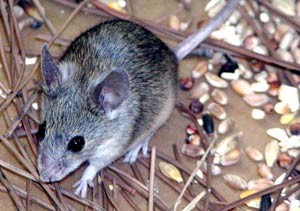New Mammal Found In Europe
Posted by: Loren Coleman on October 12th, 2006

The Times of London’s Science Editor Mark Henderson documents the following startling news, here from the article, in part:
A new mammal species — thought to be the first discovered in Europe for more than a century — has been identified by a scientist based at the University of Durham. The grey mouse, found in Cyprus by Thomas Cucchi, has been confirmed as an entirely new species by genetic tests, overturning the widespread assumption that Europe had no mammals left to be discovered. Dr Cucchi, who is French, was working on the Mediterranean island studying mouse teeth from the Stone Age period and comparing them with those of four modern mouse species when he came across a variety that seemed to differ from all known European mice.
The species, named Mus cypriacus, or the Cypriot mouse, has a larger head, ears, eyes and teeth than previously known examples. It is described in the journal Zootaxa.
The find is remarkable because new mammal species are seldom reported anywhere in the world, and most recent discoveries have emerged from regions such as New Guinea that are not densely populated and have been little studied by scientists.
The biodiversity of Europe has been combed through so extensively since Victorian times that few expected creatures as large as mice to be found.
“New mammal species are mainly discovered in hotspots of biodiversity like South East Asia and it was generally believed that every species of mammal in Europe had been identified,” Dr Cucchi said. “This is why the discovery of a new species of mouse on Cyprus was so unexpected and exciting.”
* * *
The mouse is the latest of about a dozen species of mammals discovered by scientists over the past few years.
Last month, researchers from Conservation International found a new species of tree rat in the Amapa region of the Brazilian rainforest, along with other new amphibians, lizards and fish. In May, scientists confirmed that a monkey named the kipunji, found in Tanzania last year, is the first new primate to be discovered for 83 years. It even belongs to a new genus — a level of classification one higher than the species. A new mouse was discovered recently on the island of Camiguin, in the Philippines, and last year scientists photographed a strange creature in Borneo thought to be a new species of carnivore. Most surprisingly, a bizarre rodent that was first spotted in a bushmeat market in Laos has turned out to be a member of a family of mammals that was thought to have become extinct more than 11 million years ago. The kha-nyou, or Laonastes aenigmamus , is more like an extinct family of Asian mammals called the Diatomyidae than any modern rodent.
The Times of London published their article on October 12, 2006, and said it all in their title: "Discovered: Europe’s first new mammal in 100 years".
About Loren Coleman
Loren Coleman is one of the world’s leading cryptozoologists, some say “the” leading living cryptozoologist. Certainly, he is acknowledged as the current living American researcher and writer who has most popularized cryptozoology in the late 20th and early 21st centuries.
Starting his fieldwork and investigations in 1960, after traveling and trekking extensively in pursuit of cryptozoological mysteries, Coleman began writing to share his experiences in 1969. An honorary member of Ivan T. Sanderson’s Society for the Investigation of the Unexplained in the 1970s, Coleman has been bestowed with similar honorary memberships of the North Idaho College Cryptozoology Club in 1983, and in subsequent years, that of the British Columbia Scientific Cryptozoology Club, CryptoSafari International, and other international organizations. He was also a Life Member and Benefactor of the International Society of Cryptozoology (now-defunct).
Loren Coleman’s daily blog, as a member of the Cryptomundo Team, served as an ongoing avenue of communication for the ever-growing body of cryptozoo news from 2005 through 2013. He returned as an infrequent contributor beginning Halloween week of 2015.
Coleman is the founder in 2003, and current director of the International Cryptozoology Museum in Portland, Maine.










Amazing how these things can slip past for so long.
I can understand this one getting over looked–he’s a mouse. Looks normal and most people are busy trying to get rid of them. Some of the other ones mentioned above, well, that is pretty cool. Especially the rodent from laos thought to be extinct for so long, yet it’s being sold for food. That right there is a perfect example why I always question anyone who claims to be an expert in such matters–they don’t know.
This also links in with one of my favorite ironies of all this, if that’s the correct word. There is a long held scientific disdain for local folk, and their knowledge of the environment they live in. Then there is great surprise if and when that local lore proves correct.
I don’t remember the carnivore in Borneo. Can anyone help out?
It seems we have a spanking new article now regarding the very same mammal.
Well he’s not a cat, and he’s little, but he’s cute!
Since when was Cyprus in Europe?
The Republic of Cyprus has been a member state of the European Union since May 1, 2004.
Cyprus perhaps is geographically seen by some as an Eurasian island, but historically it has had as many ties with Europe specifically – via the United Kingdom and Greece – as with the strictly Eurasian country of Turkey (which has its own ties to Europe, of course).
For purposes of descriptive zoology, Cyprus seems to have been identified as European for geobiodiversity reasons.
Fore those of you still interested, the scientists who said that this was the first mammal discovered in Europe in the past 100 years have no idea what they’re talking about. There have actually been 29 discoveries of rodents, insectivores, and bats. See Darren Naish’s wonderful blog for more.